Original and Modern Uses of Antique Pressed Glass
Back to Shared Glass Knowledge
By EAPGS members Sean George and Wendy Jones of Sean George Pressed Glass & Goblets
Goblets | Wines | Tumblers | Toothpicks | Compotes | Cake Stands | Banana Stands | Creamers | Spooner | Covered Sugar
Covered Butter | Relish Dish | Shot Glasses | Celery Vases | Rose Bowl - Buttermilks | Fruit Bowls | Bread Plates | Jelly Compote
Fruit Nappies | Water Pitchers | Milk Pitchers | Punch Bowls
Goblets
Early Pressed Glass Goblets are the perfect choice of glasses for entertaining with. Early Pressed Glass Goblets were originally Water Goblets. Today, people are using them for their original use as well as for serving wine. Many people find great pleasure in personalizing their collections, by focusing on a theme, a similarity within the pattern, collecting a specific origin of patterns (like Nova Scotia Glass), collecting goblets with pattern on the foot of the glass, fruits, flowers, and much more. The Goblets come in many different sizes, so one can set the table with both Water and Wine sized glasses. Adding to the fun and enjoyment of collecting a variety of patterns is the idea that your guests are able to pick out a favorite pattern for themselves. Not only does everyone have preferences with what appeals visually, but also what feels comfortable in your hand. In having this option available, your guests will be getting the greatest enjoyment of their beverage choice, as well as never having to worry about mixing their glass up with other guests. Using these beautiful goblets, will enhance your table display and create great discussion among your guests.
Wines
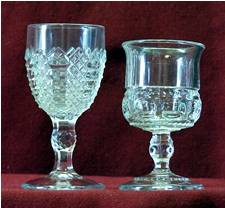 The Wine Glass of this period is very small in size, only measuring an average height of 4 inches tall. Originally, in the 1800's, our wine was shipped from Europe. This was long before we had our own vineyards in North America. Wine would travel by boat, from Europe and by horse and buggy to your town or village. This traveling greatly increased the costs of the wine, making it very expensive and only a treat after dinner. Although this seems very strange to be consuming such a small sample, the wine of the day was strong, having a high alcohol percentage, comparable to liquor today. Having made these in various sizes as well, they are very popular for liqueur, port and sherry glasses. Many collectors enjoy a fine glass of ice wine, feeling that this is most appropriate for the little antique wine glass. As part of your guest bathroom, you can leave several wines around a small decanter of mouth wash. To add colour to your table display, use the wine glasses as individual miniature flower vases at each place setting. A single rose in front of each table setting enhances the display and adds a wonderful aroma to the already eye appealing presentation. After dinner, use the little wine glasses to serve individual mints as a special treat to your important guests.
The Wine Glass of this period is very small in size, only measuring an average height of 4 inches tall. Originally, in the 1800's, our wine was shipped from Europe. This was long before we had our own vineyards in North America. Wine would travel by boat, from Europe and by horse and buggy to your town or village. This traveling greatly increased the costs of the wine, making it very expensive and only a treat after dinner. Although this seems very strange to be consuming such a small sample, the wine of the day was strong, having a high alcohol percentage, comparable to liquor today. Having made these in various sizes as well, they are very popular for liqueur, port and sherry glasses. Many collectors enjoy a fine glass of ice wine, feeling that this is most appropriate for the little antique wine glass. As part of your guest bathroom, you can leave several wines around a small decanter of mouth wash. To add colour to your table display, use the wine glasses as individual miniature flower vases at each place setting. A single rose in front of each table setting enhances the display and adds a wonderful aroma to the already eye appealing presentation. After dinner, use the little wine glasses to serve individual mints as a special treat to your important guests.
Tumblers
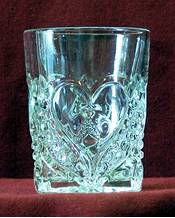 Originally Tumblers were used for serving water, juice and lemonade. The larger sized tumblers, known as Iced Teas, were intended for just the purpose by which they are named, Iced Tea Tumblers. Many people today are using these durable glasses for water (more often the iced tea size) and for juice and mixed drinks. The antique pressed glass bar tumblers, wider than the standard water tumbler are the chosen glass for scotch and whisky. Many people enjoy using the bar tumblers for mixed drinks at social events. Again, they come in many patterns, so each of your guests can have a different pattern.
Originally Tumblers were used for serving water, juice and lemonade. The larger sized tumblers, known as Iced Teas, were intended for just the purpose by which they are named, Iced Tea Tumblers. Many people today are using these durable glasses for water (more often the iced tea size) and for juice and mixed drinks. The antique pressed glass bar tumblers, wider than the standard water tumbler are the chosen glass for scotch and whisky. Many people enjoy using the bar tumblers for mixed drinks at social events. Again, they come in many patterns, so each of your guests can have a different pattern.
Toothpicks
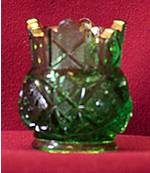 Everyone knows that is it very important to clean your teeth after every meal, but this era was before we had invented plastic, and long before the invention of the toothbrush. After mealtime, you would seek out the tiny glass container that would hold the wooden toothpicks to relieve your gums and clean your teeth. Many people have continued to use these cute little pieces for the same purpose. For serving hor d'oeuvres, display the toothpicks in several of these beautiful pieces. Using these toothpick holders is a simple and friendly way of encouraging your guests to self serve. Also, these little pieces make great tea-light candleholders. For the best effect with the light of the flame, choose a toothpick holder with lots of design and shapes in the pattern. These patterns, resembling cut glass, best reflect the light, mirroring the shapes of the pattern on the display table. It is recommended, if you are using the toothpicks as tea-light holders, use only the plastic cupped lights and avoid the metal cups. The heat with the flame and the metal could get to intense for the glass. If your tea-lights do not have cups, use sand to keep the flame from reaching the bottom. This technique also prevents the hassle of lifting hard wax from the glass. You can also purchase coloured sand from a craft store and match the colours in your room or match the colour of your tablecloth. Toothpicks can be used as individual flower vases for each place setting for the ladies at a dinner party.
Everyone knows that is it very important to clean your teeth after every meal, but this era was before we had invented plastic, and long before the invention of the toothbrush. After mealtime, you would seek out the tiny glass container that would hold the wooden toothpicks to relieve your gums and clean your teeth. Many people have continued to use these cute little pieces for the same purpose. For serving hor d'oeuvres, display the toothpicks in several of these beautiful pieces. Using these toothpick holders is a simple and friendly way of encouraging your guests to self serve. Also, these little pieces make great tea-light candleholders. For the best effect with the light of the flame, choose a toothpick holder with lots of design and shapes in the pattern. These patterns, resembling cut glass, best reflect the light, mirroring the shapes of the pattern on the display table. It is recommended, if you are using the toothpicks as tea-light holders, use only the plastic cupped lights and avoid the metal cups. The heat with the flame and the metal could get to intense for the glass. If your tea-lights do not have cups, use sand to keep the flame from reaching the bottom. This technique also prevents the hassle of lifting hard wax from the glass. You can also purchase coloured sand from a craft store and match the colours in your room or match the colour of your tablecloth. Toothpicks can be used as individual flower vases for each place setting for the ladies at a dinner party.
Compotes
 There are 2 kinds of Compotes, a Covered Compote and a True Open Compote. The True Open Compote, having a ruffled or fluted top, was intended originally to hold fresh fruit. The Covered Compote was for anything that had a liquid, such as a fruit salad, stewed peaches or rhubarb, etc. This lid was essential, as it was before screening in windows was invented. Modern uses for the compotes are many, including the original purposes. Compotes are used for serving breads, mashed potatoes, salads, cookies, squares, and much more.
There are 2 kinds of Compotes, a Covered Compote and a True Open Compote. The True Open Compote, having a ruffled or fluted top, was intended originally to hold fresh fruit. The Covered Compote was for anything that had a liquid, such as a fruit salad, stewed peaches or rhubarb, etc. This lid was essential, as it was before screening in windows was invented. Modern uses for the compotes are many, including the original purposes. Compotes are used for serving breads, mashed potatoes, salads, cookies, squares, and much more.
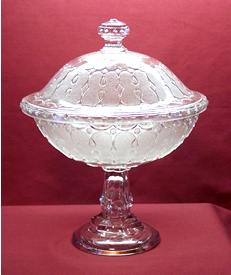 They are popular as a centre piece to float candles in, to display freshly cut flowers from the garden, or for holiday decorations like tree ornaments or Easter eggs. A popular use among those who like to use their compotes, while not being used as a serving piece, is to place a large pillar candle in the centre and make a flower arrangement circling the candle.
They are popular as a centre piece to float candles in, to display freshly cut flowers from the garden, or for holiday decorations like tree ornaments or Easter eggs. A popular use among those who like to use their compotes, while not being used as a serving piece, is to place a large pillar candle in the centre and make a flower arrangement circling the candle.
Cake Stands
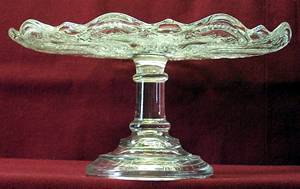 Cake Stands were made in various sizes, from 7" to 12" in width. Occasionally one may be lucky enough to find a 13" or 14" cake stand of this period. They are still very popular today for serving a cake, especially at Birthdays, Weddings and Anniversaries, and perfect for serving that special dessert at all of your parties and functions. Many say the cake stand completes the perfect cake, elevating the cake at eye level for your guests at the table, adding to the entire appeal. Many are using the cake stands for serving a cheese ball and crackers or nachos and dip. For large functions, a grouping of 2, 3 or 4 tiered cake stands are very popular. One can alternate, cookies and squares on each cake or alternate flowers and grapes. The perfect piece to top the tier is known as the Childs
Cake Stands were made in various sizes, from 7" to 12" in width. Occasionally one may be lucky enough to find a 13" or 14" cake stand of this period. They are still very popular today for serving a cake, especially at Birthdays, Weddings and Anniversaries, and perfect for serving that special dessert at all of your parties and functions. Many say the cake stand completes the perfect cake, elevating the cake at eye level for your guests at the table, adding to the entire appeal. Many are using the cake stands for serving a cheese ball and crackers or nachos and dip. For large functions, a grouping of 2, 3 or 4 tiered cake stands are very popular. One can alternate, cookies and squares on each cake or alternate flowers and grapes. The perfect piece to top the tier is known as the Childs 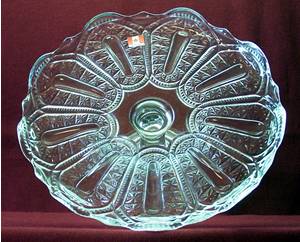 Cake Stand. This tiny Cake Stand measures 6" to 61/2" in width. The Childs Cake Stand was originally used for a child to practice setting a proper table by Mothers example. The daughter would observe her Mother setting the table and serving her guests, while the child who was nearby would entertain her dolls and teddy bears by practicing with her own pieces. They are ideal as the top cake stand to complete the tier. The 6" top surface is popular to serve chocolates and mints, or you can cut the stems of several roses, lilies or chrysanthemums, and circle them around a lit pillar candle. For safety purposes make sure that there is no movement of the cake stands stacked. If one is rocking on the surface of another, simple take a tiny piece of paper and slide it under the area that is rocking to stop the movement. An example of a great tiered display is to use a 12" as the bottom, 10" as the second on top, 7" as the third and the child's cake stand for the top. Start the bottom with an assortment of cookies, the second for green and red grapes, the third for brownies and squares, and the top a green pillar candle with 5 or 6 red roses around the candle. Adding colour to your desserts or meals makes the appearance tantalizing and a lot more fun to create!
Cake Stand. This tiny Cake Stand measures 6" to 61/2" in width. The Childs Cake Stand was originally used for a child to practice setting a proper table by Mothers example. The daughter would observe her Mother setting the table and serving her guests, while the child who was nearby would entertain her dolls and teddy bears by practicing with her own pieces. They are ideal as the top cake stand to complete the tier. The 6" top surface is popular to serve chocolates and mints, or you can cut the stems of several roses, lilies or chrysanthemums, and circle them around a lit pillar candle. For safety purposes make sure that there is no movement of the cake stands stacked. If one is rocking on the surface of another, simple take a tiny piece of paper and slide it under the area that is rocking to stop the movement. An example of a great tiered display is to use a 12" as the bottom, 10" as the second on top, 7" as the third and the child's cake stand for the top. Start the bottom with an assortment of cookies, the second for green and red grapes, the third for brownies and squares, and the top a green pillar candle with 5 or 6 red roses around the candle. Adding colour to your desserts or meals makes the appearance tantalizing and a lot more fun to create!
Banana Stands
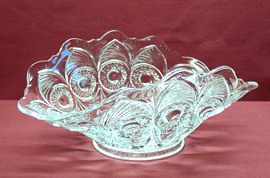 A hundred years ago, the Banana Stand was a very important piece of tableware. We all know how quickly Bananas ripen, and it was believed that bananas enhanced the ripening of the rest of your fruit, if you kept all of your fruits together. Companies designed and produced a dish to specifically hold a grouping of bananas. The Banana Stand in appearance looks like a cake stand with 2 sides folded up in a u-shape, and either came with the pedestal (banana stand) or without the pedestal (flat banana). Many people continue the original use for holding a grouping of bananas. Others have found creative ways to use this unique hundred year old dish. The banana stand is perfect for holding your paper napkins at a barbeque, or while serving hor d'oeuvres.
A hundred years ago, the Banana Stand was a very important piece of tableware. We all know how quickly Bananas ripen, and it was believed that bananas enhanced the ripening of the rest of your fruit, if you kept all of your fruits together. Companies designed and produced a dish to specifically hold a grouping of bananas. The Banana Stand in appearance looks like a cake stand with 2 sides folded up in a u-shape, and either came with the pedestal (banana stand) or without the pedestal (flat banana). Many people continue the original use for holding a grouping of bananas. Others have found creative ways to use this unique hundred year old dish. The banana stand is perfect for holding your paper napkins at a barbeque, or while serving hor d'oeuvres. 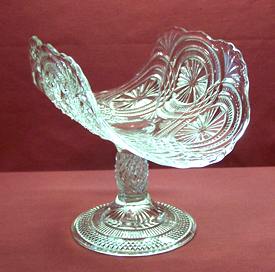 Simply take a square paper napkin, fold it in half, one point to one point, to shape a triangle. Napkins rest perfectly when placed with the fold down, matching the shape of the banana dish to the napkin. You can also wrap your utensils in a paper or cloth napkin and stack them in the banana dish, for a buffet dinner party. Many people will display a grouping of grapes in the banana stand at a wine and cheese party. The banana dish is also great for serving freshly baked bread sticks. In the guest bathroom, you can use the banana stand to hold a display of rolled up face cloths, topped with a bar of face soap and hand soap. They also can be used for a great floral display with either fresh cut flowers or a silk arrangement.
Simply take a square paper napkin, fold it in half, one point to one point, to shape a triangle. Napkins rest perfectly when placed with the fold down, matching the shape of the banana dish to the napkin. You can also wrap your utensils in a paper or cloth napkin and stack them in the banana dish, for a buffet dinner party. Many people will display a grouping of grapes in the banana stand at a wine and cheese party. The banana dish is also great for serving freshly baked bread sticks. In the guest bathroom, you can use the banana stand to hold a display of rolled up face cloths, topped with a bar of face soap and hand soap. They also can be used for a great floral display with either fresh cut flowers or a silk arrangement.
Creamers
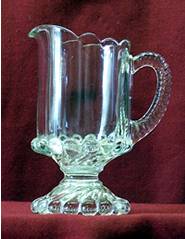 Creamers were originally part of the 4-piece breakfast set, including a spooner, covered sugar and butter dish. Originally, you would have purchased these items as a set. The creamers original purpose was to serve cream at the table. Today there are many uses including serving salad dressings, maple syrup, gravy and as a milk pitcher for tea time. For desserts, the creamer is ideal for hot fudge when serving ice cream, or for strawberry sauce when serving an angel food cake. It is perfectly safe to use with a hot liquid, but you should use a metal spoon and pour the liquid on the spoon first to break the heat.
Creamers were originally part of the 4-piece breakfast set, including a spooner, covered sugar and butter dish. Originally, you would have purchased these items as a set. The creamers original purpose was to serve cream at the table. Today there are many uses including serving salad dressings, maple syrup, gravy and as a milk pitcher for tea time. For desserts, the creamer is ideal for hot fudge when serving ice cream, or for strawberry sauce when serving an angel food cake. It is perfectly safe to use with a hot liquid, but you should use a metal spoon and pour the liquid on the spoon first to break the heat.
Spooner
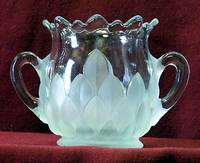 Spooners were part of the 4-piece breakfast set. Since the spoon was the most regularly utensil used at every sitting and tea time, you would fill the spooner with your spoons and leave them sitting in the centre of the table. Many people still use the spooner for its original function; however there are many other modern uses. When serving a turkey, use the spooner to serve cranberry sauce. Spooners are very popular for serving mints and jelly beans, adding a single spoon to allow your guests to help themselves is preferred. You can also use the spooner to serve croutons for dressing up salads. They are very handy to use for many different dressings and sauces, making a nice presentation. Spooners are also very popular to store your make-up brushes or toothbrushes in. Many people are also using the spooner for a small pillar candle holder. For the best effect, choose a heavy cut pattern, the light dances around the room as it is broken up by the lines in the pattern.
Spooners were part of the 4-piece breakfast set. Since the spoon was the most regularly utensil used at every sitting and tea time, you would fill the spooner with your spoons and leave them sitting in the centre of the table. Many people still use the spooner for its original function; however there are many other modern uses. When serving a turkey, use the spooner to serve cranberry sauce. Spooners are very popular for serving mints and jelly beans, adding a single spoon to allow your guests to help themselves is preferred. You can also use the spooner to serve croutons for dressing up salads. They are very handy to use for many different dressings and sauces, making a nice presentation. Spooners are also very popular to store your make-up brushes or toothbrushes in. Many people are also using the spooner for a small pillar candle holder. For the best effect, choose a heavy cut pattern, the light dances around the room as it is broken up by the lines in the pattern.
Covered Sugar
 The covered sugar was another part of the 4-piece breakfast set. It was important to have a lid to keep the insects and bugs out from the sugar as there were no screens in windows in homes during the 1880's period. Many people find the covered sugar useful for keeping soaps, bath bombs and bath salts in, and really enhance the bathroom counter display. You can even keep cotton balls or q-tips in the covered sugar. Other uses include a candy dish, sugar at a tea party, dried fruit, instant coffee or just about anything.
The covered sugar was another part of the 4-piece breakfast set. It was important to have a lid to keep the insects and bugs out from the sugar as there were no screens in windows in homes during the 1880's period. Many people find the covered sugar useful for keeping soaps, bath bombs and bath salts in, and really enhance the bathroom counter display. You can even keep cotton balls or q-tips in the covered sugar. Other uses include a candy dish, sugar at a tea party, dried fruit, instant coffee or just about anything.
Covered Butter
The covered butter was meant to hold a slab of butter, which was used in greater quantity than we tend to use now. Again, this was before refrigeration, so it was essential for this dish to be covered. They are quite large, and so are very popular to serve a cheese ball, hor d'oeuvres or even a covered chocolate/truffle dish for desserts
Relish Dish
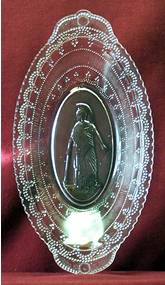 The relish dish was intended to serve relish or garnishes at the table. The dish is either oblong, oval or rectangular in shape. Today, relish dishes are very popular for serving asparagus, celery and pickles. Relish dishes are also used in the bathroom for hand soap, assortments of bath beads or small figural soaps. They are also popular for displaying potpourri, or dried flowers. It is also very popular to put a layer of coloured sand in the bottom, and place several tea lights into the sand. Using the sand prevents the wax from sticking to the surface of the glass and makes for a much easier clean-up after the candles have finished burning.
The relish dish was intended to serve relish or garnishes at the table. The dish is either oblong, oval or rectangular in shape. Today, relish dishes are very popular for serving asparagus, celery and pickles. Relish dishes are also used in the bathroom for hand soap, assortments of bath beads or small figural soaps. They are also popular for displaying potpourri, or dried flowers. It is also very popular to put a layer of coloured sand in the bottom, and place several tea lights into the sand. Using the sand prevents the wax from sticking to the surface of the glass and makes for a much easier clean-up after the candles have finished burning.
Shot Glasses
These little glasses are very popular today for their original use, especially now that there is a wider variety of flavoured shots. They are now commonly used in the guest bathroom for mouthwash, and you can leave several for your guests without using up a lot of counter space. Other uses include, individual flower vases at each place setting, individual candies for an after dinner treat for each of your guests and to store bobby pins or sewing pins.
Celery Vase
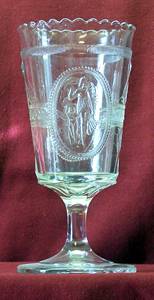 The celery vase looks like a flower vase that is straight sided, and comes either on a pedestal or without the pedestal, known as a flat celery vase. In the late 1800's, the celery vase sat in the centre of you table all day. Your mother would fill the celery vase with fresh well water, chop up celery and place the celery sticks inside the vase in the fresh water. The water would keep the celery crisp all day long, and celery was your snack to tide you over until mealtime. When not being used to hold celery sticks, today they are commonly used for bread sticks, to serve steak knives, to hold a pillar candle, and also as a flower vase.
The celery vase looks like a flower vase that is straight sided, and comes either on a pedestal or without the pedestal, known as a flat celery vase. In the late 1800's, the celery vase sat in the centre of you table all day. Your mother would fill the celery vase with fresh well water, chop up celery and place the celery sticks inside the vase in the fresh water. The water would keep the celery crisp all day long, and celery was your snack to tide you over until mealtime. When not being used to hold celery sticks, today they are commonly used for bread sticks, to serve steak knives, to hold a pillar candle, and also as a flower vase.
Rose Bowl
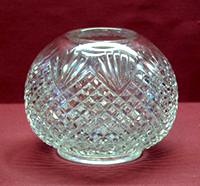 The rose bowl was designed to hold an individual floating rose for decoration in your home. Rose bowls can also be used to hold potpourri, as tea light candleholders, as a small planter, to hold powder puffs or to store cotton balls.
The rose bowl was designed to hold an individual floating rose for decoration in your home. Rose bowls can also be used to hold potpourri, as tea light candleholders, as a small planter, to hold powder puffs or to store cotton balls.
Buttermilks
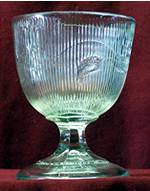 This glass is shorter than the goblet, with a wider circumference. It was used originally to drink buttermilk. Today they are very popular for individual dessert dishes or for ice creams and sherbets because of their wide size, and how low they sit on the table. They are also very handy to use to serve sauces. As drinking glasses they are used for beer glasses (holding exactly one beer), and for mixed drinks like rum and coke. Buttermilks are also used as candies or for a shrimp cocktail (sauce in the bowl & shrimp hung around the rim).
This glass is shorter than the goblet, with a wider circumference. It was used originally to drink buttermilk. Today they are very popular for individual dessert dishes or for ice creams and sherbets because of their wide size, and how low they sit on the table. They are also very handy to use to serve sauces. As drinking glasses they are used for beer glasses (holding exactly one beer), and for mixed drinks like rum and coke. Buttermilks are also used as candies or for a shrimp cocktail (sauce in the bowl & shrimp hung around the rim).
Fruit Bowls
The fruit bowl was originally used to hold your fruits (apples, oranges, pears, grapes, etc.) and to serve fruit salads. They are commonly used for their original purpose as well as to serve salads, trifles, fruit salads, mashed potatoes, corn, pretzels, potato chips, etc. They come in a variety of sizes and depths for a great variety of uses. When not being used as a serving piece, many people will use the fruit bowl to display potpourri, dried flowers, decorative stones or for a floating candle display.
Bread Plates
The bread plate was used to serve a loaf of bread. They came flat or having a slight slope and either rectangular or round. Many people are using bread plates to serve a grouping of sandwiches at a lunch party, to serve cookies, squares and an assortment of fudge and chocolate. By placing a fruit nappy (what looks like a small sauce dish) in the centre, the bread plate can be used for serving veggies and dip. They also display, very nicely, a cheese ball and crackers.
Jelly Compote
 The jelly compote is small pedestal compote, miniature of the full-size compote, used originally to serve jellies and chutney's at the table. This was important because people did not have the spices we have now, and meats were very bland. They are popular now as individual dessert dishes, for serving ice creams or fruit salads. They are also used as candy dishes or to display and individual pillar candle. It can also be used for serving cranberry sauce with the holiday turkey!
The jelly compote is small pedestal compote, miniature of the full-size compote, used originally to serve jellies and chutney's at the table. This was important because people did not have the spices we have now, and meats were very bland. They are popular now as individual dessert dishes, for serving ice creams or fruit salads. They are also used as candy dishes or to display and individual pillar candle. It can also be used for serving cranberry sauce with the holiday turkey!
Fruit Nappies
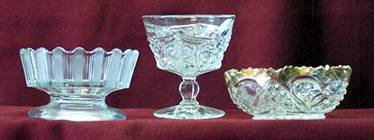 The fruit nappy was used as an individual fruit dish, and was usually bought in a set with the fruit bowl. They vary in size depending on the pattern. The nappies that are small in size are great as nut dishes at a card party. The larger sized nappies are popular for serving desserts or as finger bowls. They are also very popular today, and affordable to put a votive candle in. Many people enjoy putting them on the bathroom counter with a candle, on the counter beside the tub while bathing, on the night table, decorating windows, just about anywhere.
The fruit nappy was used as an individual fruit dish, and was usually bought in a set with the fruit bowl. They vary in size depending on the pattern. The nappies that are small in size are great as nut dishes at a card party. The larger sized nappies are popular for serving desserts or as finger bowls. They are also very popular today, and affordable to put a votive candle in. Many people enjoy putting them on the bathroom counter with a candle, on the counter beside the tub while bathing, on the night table, decorating windows, just about anywhere.
Water Pitchers
 The Water Pitcher was an essential part of your tableware setting. They were produced in many different shapes and sizes. Some are round and bulbous, others are tall and slender. The "bulbous" shaped water pitchers are ideal to have for serving a variety of beverages, including lemonade, iced tea, red or white wine and of course for serving water. These water pitchers are also popular for making a large flower arrangement, as they are similar in size and shape to many modern flower vases. The "tall tankard" water pitchers are commonly used for serving ice water, champagne, red or white wine and special fruit cocktails. The "tankard" water pitcher is ideal for smaller arrangements, with flowers that tend to have longer stems, such as roses and lilies or arrangements with one or two different flowers. Many people will dry flowers, and use the water pitchers as permanent decorative vases. There are two different kinds of water pitchers categorized by the handle of the pitcher. In the early stages of mold designing, it was known how to make a "one plunger" mold. This meant that mold makers would design a mold to press the body of the pitcher. After the body was pressed, a glass blower was hired to "blow and apply" the handle to the body of the pitcher. Often during this process the body of the pitcher would crack from the application of a hot handle attaching to the pitcher that had already cooled. If cracking occurred, the glass was melted and used to make another water pitcher. It wasn't long until they discovered a "two plunger" mold, where the mold makers could press the handle directly to the body of the pitcher. The pitchers with a "pressed handle," are more common as they were able to mass produce them, where the "applied handled" water pitchers are not as common, and harder to find, as there were not as many produced. Although the "applied handle" water pitchers tend to be more expensive, it is important to remember that pressed glass is very durable and that when you buy pressed glass you are investing in an antique that will last your life-time with simply care and not to be afraid to use it while it appreciates in value.
The Water Pitcher was an essential part of your tableware setting. They were produced in many different shapes and sizes. Some are round and bulbous, others are tall and slender. The "bulbous" shaped water pitchers are ideal to have for serving a variety of beverages, including lemonade, iced tea, red or white wine and of course for serving water. These water pitchers are also popular for making a large flower arrangement, as they are similar in size and shape to many modern flower vases. The "tall tankard" water pitchers are commonly used for serving ice water, champagne, red or white wine and special fruit cocktails. The "tankard" water pitcher is ideal for smaller arrangements, with flowers that tend to have longer stems, such as roses and lilies or arrangements with one or two different flowers. Many people will dry flowers, and use the water pitchers as permanent decorative vases. There are two different kinds of water pitchers categorized by the handle of the pitcher. In the early stages of mold designing, it was known how to make a "one plunger" mold. This meant that mold makers would design a mold to press the body of the pitcher. After the body was pressed, a glass blower was hired to "blow and apply" the handle to the body of the pitcher. Often during this process the body of the pitcher would crack from the application of a hot handle attaching to the pitcher that had already cooled. If cracking occurred, the glass was melted and used to make another water pitcher. It wasn't long until they discovered a "two plunger" mold, where the mold makers could press the handle directly to the body of the pitcher. The pitchers with a "pressed handle," are more common as they were able to mass produce them, where the "applied handled" water pitchers are not as common, and harder to find, as there were not as many produced. Although the "applied handle" water pitchers tend to be more expensive, it is important to remember that pressed glass is very durable and that when you buy pressed glass you are investing in an antique that will last your life-time with simply care and not to be afraid to use it while it appreciates in value.
Milk Pitchers
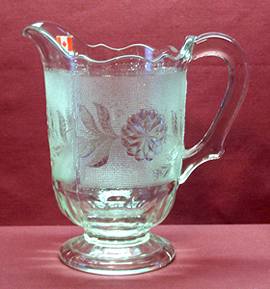 The milk pitcher was part of your table setting in the 1880's. Similar to the water pitcher, milk pitchers came in various shapes and sizes, both with applied handles and pressed handles, but are generally smaller in size. Milk pitchers are popular today for salad dressings, syrup and gravy. They are also ideal if you are serving a selection of wines (red, white, blush), next to the water pitcher for your ice water. They are ideal for specialty drinks, like eggnog, tomato or vegetable cocktails, or for serving juices at the breakfast table. Milk pitchers are also used for smaller flower arrangements.
The milk pitcher was part of your table setting in the 1880's. Similar to the water pitcher, milk pitchers came in various shapes and sizes, both with applied handles and pressed handles, but are generally smaller in size. Milk pitchers are popular today for salad dressings, syrup and gravy. They are also ideal if you are serving a selection of wines (red, white, blush), next to the water pitcher for your ice water. They are ideal for specialty drinks, like eggnog, tomato or vegetable cocktails, or for serving juices at the breakfast table. Milk pitchers are also used for smaller flower arrangements.
Punch Bowls
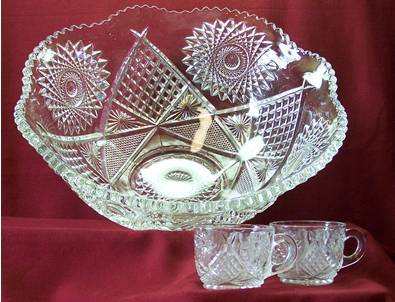 Punch bowls were used for serving a number of guests at a family or social function. The punch bowls came with either a pedestal to elevate the bowl on the table or a large underplate where the bowl would rest in the centre. Each set came with a set of punch cups. If a pedestal was used the cups were hung around the bowl using metal hooks. If the punch tray was used, the cups were displayed around the base of the bowl resting on the tray. Today, the punch sets are still used for serving punches as well as special holiday drinks, such as eggnog. When being used for punch, to add to the presentation, thinly slice an orange and add it to the punch. The orange slices float along the top, adding colour and appeal. An alternative to oranges are lemons or limes, depending on the flavor of your punch. For more colour, add cranberries or strawberries. When not being used for serving punches or specialty drinks, there are many other great uses. The punch bowls are popular for displaying colourful decorative balls, floating candles or as a large rose bowl (floating a variety of flowers in water). They are popular as a decoration for the centre of your table or on a sideboard. The large size of a punch bowl set makes an impressive statement just on it's own. Many people today also use their Punch Bowls to serve salads at a large function. They are perfect for Caesar salads because you have good depth to mix the salad ingredients.
Punch bowls were used for serving a number of guests at a family or social function. The punch bowls came with either a pedestal to elevate the bowl on the table or a large underplate where the bowl would rest in the centre. Each set came with a set of punch cups. If a pedestal was used the cups were hung around the bowl using metal hooks. If the punch tray was used, the cups were displayed around the base of the bowl resting on the tray. Today, the punch sets are still used for serving punches as well as special holiday drinks, such as eggnog. When being used for punch, to add to the presentation, thinly slice an orange and add it to the punch. The orange slices float along the top, adding colour and appeal. An alternative to oranges are lemons or limes, depending on the flavor of your punch. For more colour, add cranberries or strawberries. When not being used for serving punches or specialty drinks, there are many other great uses. The punch bowls are popular for displaying colourful decorative balls, floating candles or as a large rose bowl (floating a variety of flowers in water). They are popular as a decoration for the centre of your table or on a sideboard. The large size of a punch bowl set makes an impressive statement just on it's own. Many people today also use their Punch Bowls to serve salads at a large function. They are perfect for Caesar salads because you have good depth to mix the salad ingredients.
Reproduced with the kind permission of Sean George Pressed Glass & Goblets - www.pressedglassandgoblets.com
Back to Shared Glass Knowledge
